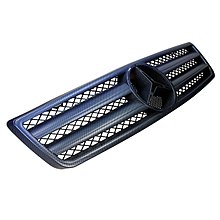Water transfer printing
The water pressure transfer is a surface coating method , can be over the entire surface covered with a pattern or decoration by the objects. This works with almost all surfaces in almost all two- and three-dimensional shapes, even if the objects do not have straight edges and surfaces. Almost all materials such as plastic, metal, ceramic, leather or glass can be coated with the water transfer printing process.
Special films are used as the transfer medium and are available in a wide range of patterns, e.g. B. in carbon or root wood look. The coating process takes place in a water bath.
Areas of application
One of the largest areas of application is the automotive industry . Here, for example, car interior parts are coated with a root wood or carbon look. The technology is also used in the maritime, aerospace and aerospace industries. Here z. B. the covers of cockpit instruments and various elements of the interior for reasons of weight savings treated accordingly. Water transfer printing is even used today in the furniture sector, the household appliance industry and the office supplies industry.
Water transfer printing is also used in the hobby and private sector, e.g. B. for the refinement of components for cars, two-wheelers, quads or everyday objects are becoming increasingly popular.
Description of the procedure
First, the component to be coated is pretreated by applying a basecoat. On the one hand, the basecoat has the function of increasing the adhesion of the decor and, on the other hand, gives the component the corresponding basic color. Because depending on the decor, the basecoat is partially visible. This also enables a wide range of possible variations, even with the same decor and different basecoat.
After the basecoat has been applied to the component and has dried, the water-soluble water transfer printing film made of polyvinyl alcohol (PVA) is placed on the surface of the water in a dip tank (also known as a dipper) and soaked for 60 to 180 seconds, depending on the film thickness. The decorative film is applied either manually or by machine. The PVA carrier material dissolves in the 30 ° C warm water.
Then the decorative film is activated by applying a special activator evenly . The application takes place in the spray process either manually or with the fully automatic systems via automatic spray guns. In the case of fully automatic conveyor systems, the activator can also be applied via a roller system before the decorative film is placed on the water. In all cases, the activator dissolves the pigments and the decorative film floats on the surface of the water.
The components are then immersed in the water through the decorative film at a defined angle and at slow speed. Due to the intrinsic pressure of the water, the decor wraps itself around the component without bubbles and is thus transferred. Here, too, manual or automated machine solutions are available, depending on the size of the system. The decoration is connected to the component directly. The decor is now so solid that touching it during handling no longer has a negative effect.
The PVA residues are then washed off, the component is dried and finally sealed with clear varnish. The decor is now UV-resistant and abrasion-proof. Various “washers” are available for the washing process, each of which is adapted to the size of the dipper used.
Dipper & Washer
A plunge pool in water transfer printing is called a dipper. Such basins are mainly used in the craft, commercial and industrial sectors and offer the possibility of manually and (fully) automatically coating objects from prototypes to small series to large series. Dippers are available in small, compact designs from 50 cm wide up to large machines with a length of 3 meters. Depending on the size and degree of automation, dippers have a coating capacity of between 4 and 120 m² decor surface per hour.
The washer is the perfect washing system addition to a dipper. A washer is a housing similar to a large dishwasher with washing nozzles and a manually adjustable washing grille. The rotating nozzles free the coated components all around from the adhering polyvinyl alcohol film residues, so that they can be perfectly varnished after drying.
literature
- Technical product design manual . Springer, Berlin 2011, ISBN 978-3-642-02641-6 .
- Wilfried Juling, Adolf Schreiner: Multimedia Transfer . Univ.-Verl. Karlsruhe, Karlsruhe 2005, ISBN 3-937300-36-8 .




